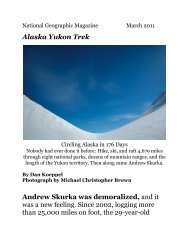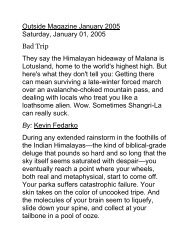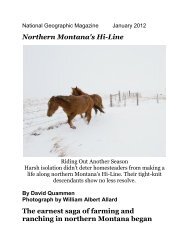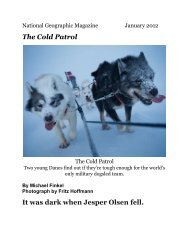Wolf Wars.pdf - ePetersons.com
Wolf Wars.pdf - ePetersons.com
Wolf Wars.pdf - ePetersons.com
You also want an ePaper? Increase the reach of your titles
YUMPU automatically turns print PDFs into web optimized ePapers that Google loves.
<strong>Wolf</strong> <strong>Wars</strong><br />
<strong>Wolf</strong> <strong>Wars</strong><br />
Packs are making a <strong>com</strong>eback. That’s a thrill for<br />
wildlife lovers. But wolves are still wolves,<br />
killing cattle and elk. Many Westerners are<br />
angry. And so, the age-old fight over land and<br />
food has begun anew.<br />
By Douglas Chadwick<br />
Photograph by Jeff Vanuga<br />
Wolves, when you get down to it, are a lot like<br />
us.
They are powerful, aggressive, territorial, and<br />
predatory.<br />
They are smart, curious, cooperative, loyal, and<br />
adaptable.<br />
They exert a profound influence on the<br />
ecosystems they inhabit.<br />
Nevertheless, we have problems with wolves, no<br />
doubt about it. Maybe we can't wrap our minds<br />
around both the big bad wolf and the close<br />
relative with the adoring gaze that follows us<br />
around the house. Or maybe it's because gray<br />
wolves are the planet's most widespread large<br />
land mammals after humans and their livestock<br />
and—in the Northern Hemisphere—have long<br />
been our most direct <strong>com</strong>petitors for meat.<br />
Whatever the reasons, humans are at war with<br />
wolves. It is an ancient dispute over territory<br />
and food between their clans and ours, and its<br />
battleground spreads across the northern Rocky<br />
Mountain states and right up to the door of my<br />
remote cabin near Montana's Glacier National<br />
Park. A young female named Diane marked the<br />
place by peeing on the front-porch mat.
There is a den not too far away atop a timbered<br />
knoll sheltered by overhanging boughs. Dug<br />
between tree roots, the opening gapes like a<br />
maw and extends underground for 18 feet—a<br />
manor by wolf standards. The ground around it<br />
is worn bare by generations of pawed feet. Paths<br />
lead to an open hillside overlooking a mile-long<br />
meadow fringed by autumn-colored aspen and<br />
willow, hushed except for the occasional call of<br />
a raven. The snowy peaks of the Continental<br />
Divide rise in the distance, and a wild river<br />
flows close by. <strong>Wolf</strong> tracks intersect with the<br />
prints of elk, deer, moose, and grizzly bears.<br />
Though the pups reared here are running with<br />
the adults now, the pack isn't far away,<br />
according to the radio signals of the alpha<br />
female.<br />
Many had thought the war was over.<br />
Relentlessly shot, trapped, and poisoned, even<br />
in nature reserves, gray wolves were gone from<br />
the West by the 1930s. In 1974, when Canis<br />
lupus was declared endangered in the lower 48<br />
states, the gray wolf population was confined to<br />
a corner of northern Minnesota and Michigan's<br />
Isle Royale National Park out in Lake Superior.
Then, during the mid-1980s, a handful trotted<br />
down the Continental Divide from Canada. Two<br />
settled in the hidden meadow in Glacier and in<br />
1986 reared five pups. Footsore biologists trying<br />
to keep track of the new<strong>com</strong>ers dubbed them<br />
the Magic pack for the way they seemed to<br />
vanish and reappear like wisps of ground fog.<br />
The pack grew and soon split into two, then<br />
three, keeping mostly within the park. Some<br />
animals broke away and dispersed to<br />
neighboring national forests. Then all at once, a<br />
pair was denning on private ranchland 90 miles<br />
southwest of Glacier and less than 30 miles<br />
from the Idaho border. People began to report<br />
wolves in both Idaho and northern Wyoming.<br />
Still, there was no proof those wolves were<br />
anything but passing wanderers. Not yet.<br />
In 1995 and 1996, the U.S. Fish and Wildlife<br />
Service captured wolves in Canada and released<br />
them into 2.2-million-acre Yellowstone<br />
National Park and central Idaho's wilderness<br />
areas. The unprecedented federal action<br />
triggered such an eruption of hope, fear,<br />
resentment, lawsuits, and headline news that
most people assume the whole return of the<br />
wolf to the West began that way. It didn't, but<br />
those reintroductions worked like a rocket<br />
booster. Populations grew, and the war<br />
escalated.<br />
During 2008, wildlife agents confirmed 569<br />
cattle and sheep deaths from wolves throughout<br />
the West. That amounted to less than one<br />
percent of livestock deaths in the region, but the<br />
damage is never distributed equally. The same<br />
year 264 wolves were killed for attacking<br />
livestock in Montana, Idaho, and Wyoming.<br />
That's a big number, but it was taken from a<br />
wolf population now grown to around 1,600,<br />
roaming the region in more than 200 packs.<br />
Today there are two new packs in northeastern<br />
Washington and, some whisper, a small enclave<br />
in Colorado as well. The West is getting wilder<br />
by the hour.<br />
Wildlife enthusiasts and tourists couldn't be<br />
happier. In Yellowstone alone, tens of<br />
thousands <strong>com</strong>e to watch wolves each year,<br />
adding an estimated $35 million to the area's<br />
economy. Scientists are documenting ecological
changes tied to this top predator's return that<br />
may hold the potential to repair out-of-balance<br />
wildlands, making them more stable and<br />
biologically diverse.<br />
On the other hand, some folks say they no<br />
longer feel as safe taking their families into the<br />
woods. Sportsmen <strong>com</strong>plain too—bitterly. To<br />
many out West, where interior decorating tends<br />
to involve antlers and <strong>com</strong>e fall, "Howdy" is<br />
replaced by "Get your elk yet?" wolves are<br />
depicted as four-legged killing machines—land<br />
piranhas—ravaging game populations. Guys<br />
mutter about taking matters into their own<br />
hands and to hell with the Feds. Bumper<br />
stickers show a crossed-out wolf and the slogan<br />
"Smoke a Pack a Day."<br />
In May 2009, the wildlife service declared the<br />
species recovered in the northern Rocky<br />
Mountains and handed over responsibility for<br />
them to Montana and Idaho. Both instantly<br />
labeled them game animals and set quotas for<br />
the first legal wolf hunts in either state's<br />
memory—75 in Montana, 220 in Idaho. "It's<br />
amazing—from a single, endangered pack to a
huntable surplus across a whole region," says<br />
Jim Williams, the Montana Department of Fish,<br />
Wildlife & Parks wildlife program manager for<br />
northwest Montana. "This is the most striking<br />
Endangered Species Act success story I can<br />
think of." Maybe. In November 2009, Idaho<br />
extended its season to last until the quota is<br />
met, or until March 31, whichever is sooner. The<br />
change could open the door to hunters traveling<br />
by snowmobile and to the killing of pregnant<br />
females.<br />
After an earlier federal decision to delist<br />
Western wolves in 2008, Wyoming essentially<br />
defined the animals as varmints, or pests,<br />
allowing virtually unlimited shooting and<br />
trapping year-round. A resulting lawsuit forced<br />
the wildlife service to temporarily put wolves<br />
back on the endangered list. (Since then, the<br />
service has refused to take them off in Wyoming<br />
until that state <strong>com</strong>es up with a different plan.)<br />
Meanwhile, a coalition of 14 environmental and<br />
animal protection organizations led by<br />
Earthjustice is suing the federal government to<br />
relist all wolves until the Western states develop<br />
a regional conservation strategy that includes
core protected areas and buffer zones where<br />
wolves can live in normal packs that won't get<br />
shot to pieces.<br />
John and Rae Herman run 800 head of Angus<br />
cattle in western Montana's Hot Springs area.<br />
They grew up in America's golden age for<br />
pastoralists, in rolling valleys of bunchgrass and<br />
sage with forested mountainsides—with<br />
virtually all large native predators wiped off the<br />
landscape.<br />
"We'd usually be missing three to five calves at<br />
roundup," John says. "Now it's closer to 25.<br />
This spring our calving grounds down near the<br />
house got hit. Seven calves were confirmed wolf<br />
kills, so we were reimbursed for them."<br />
The trouble is if ranchers don't <strong>com</strong>e across a<br />
carcass right away, scavengers may drag off or<br />
shred all the evidence. Many say in some areas<br />
the actual kills by wolves may average as high as<br />
seven for every one that can be proved, but no<br />
confirmation, no <strong>com</strong>pensation. And dead and<br />
missing animals are only part of the toll. Cattle<br />
harassed by wolves over one season can lose 30<br />
to 50 pounds each. On top of that, hormonal
effects from stress kick in. "We had 85 pregnant<br />
heifers this spring, and 60 aborted," John says.<br />
"The worst part," Rae says, "is that 23 of the<br />
cows that aborted were in our son's starter herd<br />
of 25. He's stuck with a $7,500 bank note and<br />
two calves to pay it off with. We'll end up selling<br />
some mother cows to offset our losses, so we'll<br />
be going backwards."<br />
Stock with leg injuries from chases or infections<br />
from wounds be<strong>com</strong>e unmarketable. And after<br />
brushes with wolves, mother cows stay ornery<br />
and extra protective of calves. The Hermans<br />
aren't the only ranchers to say it is harder to<br />
wrangle such cattle in pens; who don't even<br />
think about using their dogs; who consider the<br />
fact that if you drive those cows onto prime<br />
range the next summer, they may not stay<br />
because the upland forests are where the wolves<br />
hang around.<br />
The Blackfoot Challenge ranchers—a<br />
cooperative established in 1993 to conserve the<br />
rural setting in west-central Montana's<br />
Blackfoot River watershed—are trying a range<br />
rider program. I'm patrolling with the lone rider
himself, Peter Brown, who travels by pickup<br />
truck, motorcycle, or foot. He monitors the<br />
whereabouts of wolf packs in relation to cattle<br />
and reports daily to ranchers so they can move<br />
herds to safer grazing spots or keep a closer eye<br />
on them. Electric fencing now surrounds<br />
calving lots in many risky areas. To visually<br />
warn wolves away from other pastures, Brown<br />
sometimes turns to the old European technique<br />
called fladry, stringing wire with bright flags<br />
along its length.<br />
As we scan some bottomlands amid October<br />
snow flurries, Brown's gaze is drawn by ravens,<br />
among his surest guides, to a carcass. In this<br />
case the birds are merely scavenging elk guts<br />
left by a human hunter. So is a raven-black wolf<br />
from the Elevation Mountain pack. Yet four<br />
deer are grazing peacefully across a fence line,<br />
and scores of cattle are doing the same 200<br />
yards beyond.<br />
"A herd's behavior is our early warning system,"<br />
Brown notes. "What I look for is cattle bunched<br />
up or running, or just looking around alertly<br />
and calling. I also keep an eye out for unhealthy
stock, which can attract predators. I think that<br />
just by moving around the area, my presence<br />
deters wolves from killing livestock. The wolves<br />
are learning and adapting at least as fast as we<br />
are. Besides that, we have good populations of<br />
natural prey here. I've seen wolves walk right<br />
through cattle herds to stalk deer."<br />
Ranchers used to leave stock that died of<br />
disease, birthing problems, and accidents lying<br />
on the range or collected in heaps called bone<br />
piles. But "as predators began to recover, the<br />
carcasses kept luring them into trouble,"<br />
explains Seth Wilson, a conservation biologist<br />
who coordinates the range rider program. "Now<br />
we collect carcasses right away and <strong>com</strong>post<br />
them at a distant site. It's one of the simplest<br />
and most effective ways to reduce conflicts with<br />
both bears and wolves. It just requires changing<br />
old habits."<br />
The question is no longer how to get rid of<br />
wolves but how to coexist with them. Family<br />
rancher David Mannix says, "We have to realize<br />
that the general U.S. population wants wolves.<br />
That population is also our customers for beef.
It's not a good idea to tell your customers they<br />
don't know what they're doing. So instead of<br />
taking a hard line and fighting to get everything<br />
back to where it was 50 years ago, we're trying<br />
things like the range rider."<br />
"But if ranchers can't make a living," stockman<br />
and veterinarian Ron Skinner says, "the<br />
alternative these days is usually subdivision for<br />
real estate, and there goes an awful lot of the<br />
open space and prime wildlife habitat in the<br />
West."<br />
When the new wolves in Yellowstone first came<br />
calling, the area's elk and moose stood their<br />
ground as though they were still dealing with<br />
coyotes. Bad plan. Today Yellowstone holds half<br />
the elk it did 15 years ago. Yet by most measures<br />
the population had swelled too high, and their<br />
range was deteriorating. Shortly after killing the<br />
last Yellowstone wolves in 1926, park officials<br />
were culling elk by the thousands. The elk kept<br />
rebounding and overgrazing key habitats,<br />
creating a perpetually unnatural situation for a<br />
park intended to preserve nature.
With a near-unlimited meat supply,<br />
Yellowstone's new wolves rapidly multiplied.<br />
But the count abruptly fell in 2005. It increased<br />
again, reaching 171 in 2007, then sank to 124 by<br />
the end of 2008, a 27 percent drop this time.<br />
Doug Smith, leader of the Yellowstone <strong>Wolf</strong><br />
Project, recorded the fewest breeding pairs<br />
since 2000. "We have a declining wolf<br />
population," he says. "Numbers never got as<br />
high as we expected based on the availability of<br />
prey. This suggests that once wolves reach a<br />
certain density, you start to get social regulation<br />
of their numbers."<br />
Clashes with humans are by no means the only<br />
wolf wars under way.<br />
Yellowstone's Druid Peak pack established its<br />
territory in 1996 and has held it ever since. In<br />
all probability they have been the most watched<br />
group of wolves in the world: The wide-open<br />
country they claim on both sides of Wyoming's<br />
Lamar River Valley is bisected by one of the<br />
park's main roads. On a late October morning<br />
the temperature is reading 4°F. Hoarfrost coats<br />
the noses of bison below one of the Druids'
favorite rendezvous sites. Scattered elk graze<br />
the same slope, and two coyotes are picking<br />
over the remains of an elk calf on the river's<br />
shore. I spy no wolves, but Laurie Lyman, a<br />
former teacher who moved from California to<br />
be near Yellowstone's wolves and has watched<br />
them almost daily for several years, lowers her<br />
binoculars to tell me about the ones she saw<br />
yesterday.<br />
Two Druids—a female labeled Number 571 and<br />
her younger brother, called Triangle Blaze, for<br />
his white chest patch—were traveling by the<br />
river when three invaders from the new Hurricane<br />
Mesa pack appeared. The groups<br />
exchanged howls and then ran at each other.<br />
Outnumbered, the Druid pair gave way first, but<br />
the Hurricanes caught up to 571. Four times<br />
they pulled her down onto her back. The final<br />
time two held her on either end while the<br />
third—and largest—bit into her chest, shaking<br />
and tearing with its teeth. "That's when Triangle<br />
Blaze jumped in," Lyman recalls. "He came to<br />
her rescue, fighting off the Hurricanes. They<br />
started chasing him, but not before 571 got in a<br />
bite on one's rear. She escaped across the river.
When her brother finally rejoined her, he was<br />
limping, and she was bleeding from her<br />
wounds."<br />
During 2008, Yellowstone saw twice as many<br />
wolves killed by other wolves as in any previous<br />
year. Distemper claimed a record share too,<br />
after hitting the population in 1999, 2000, and<br />
2005 as well. Parvovirus, another deadly canine<br />
disease, has been detected in the area. And like<br />
many packs, the Druids are suffering serious<br />
hair loss from an epidemic of mange.<br />
Loss of superabundant prey is another issue,<br />
Smith says. There are still close to 10,000 elk<br />
wintering in Yellowstone and perhaps double<br />
that number summering in the park. "But<br />
wolves are very selective hunters," Smith says.<br />
"What counts for them is the amount of<br />
vulnerable prey."<br />
Much as experience with wolves can transform<br />
cattle into not-so-domestic animals, packhunted<br />
elk turn into less vulnerable quarry.<br />
They be<strong>com</strong>e more vigilant and keep on the<br />
move more. In the wolfless era, herds<br />
practically camped at favorite winter dining
spots, foraging on young aspen, willow, and<br />
cottonwood until the stems grew clubbed and<br />
stunted like bonsai plants. Released from such<br />
grazing pressure, saplings now shoot up to form<br />
lush young groves. More songbirds find nesting<br />
habitat within their leafy shade. Along<br />
waterways, vigorous willow and cottonwood<br />
growth helps stabilize stream banks. More<br />
insects fall from overhanging stems to feed fish<br />
and amphibians. Beavers find enough<br />
nutritious twigs and branches to support new<br />
colonies.<br />
Surveying the huge northern range, where most<br />
of the park's elk winter, Doug Smith turned up<br />
just one beaver colony in 1996—the lowest tally<br />
in decades. By 2009, he recorded 12. Along<br />
Crystal Creek I find another recent beaver dam<br />
storing water, releasing a more constant flow<br />
for riparian species downstream through the<br />
dry months. Ponds and marshes that form<br />
behind the dams create habitat for moose,<br />
muskrat, mink, waterfowl, wading birds, and an<br />
array of other wildlife. After wolves moved in,<br />
cougars that had begun hunting the valleys<br />
retreated to the steep, rocky terrain they
normally inhabit. The big canines killed nearly<br />
half the coyote population. They may have<br />
rebounded a bit, but the coyotes now live in<br />
groups with shrunk territories or as vagabond<br />
"floaters." With less <strong>com</strong>petition from elk for<br />
grasses, bison may be doing better than ever.<br />
From a single new predatory force on the landscape,<br />
a rebalancing effect ripples all the way to<br />
microbes in the soil. Biologists define the series<br />
of top-down changes as a trophic cascade. In a<br />
nod to the behavioral factors at play, others<br />
speak of the "ecology of fear."<br />
Cristina Eisenberg is a five-foot-two-inch,<br />
hundred-pound answer to the question of how<br />
dangerous wolves are to people. Over the past<br />
four years she has studied wolves, elk, and<br />
aspen in Glacier Park, often on its west side<br />
among two large wolf packs, one with 20-plus<br />
members. They sometimes watch as she and an<br />
assistant measure habitat features. Then the<br />
wolves pull out her marker stakes. During a<br />
blinding snowstorm, they silently took down an<br />
elk a stone's throw from Eisenberg.
Our afternoon survey leads to a trampled-down<br />
rendezvous site. The Dutch pack has dragged in<br />
ceramic shards, cans, pots, pieces of iron tools<br />
from abandoned homesteads in the park.<br />
Canine junk collectors. Who knew?<br />
But what Eisenberg wants to show me is an<br />
aspen stand. Its upper tier consists of towering<br />
trees that arose between 1840 and the 1920s,<br />
before wolves were eliminated. The bottom row,<br />
15 feet high, is of saplings that shot up after<br />
wolves returned. There are no aspens in<br />
between. None got past the elk's mouths. By<br />
contrast with Yellowstone, elk numbers haven't<br />
changed much here. As far as Eisenberg can tell,<br />
the recent aspen growth is almost all due to<br />
wolf-inspired changes in elk behavior.<br />
The wolves' diet here is mostly white-tailed<br />
deer. Northwestern Montana has at least twice<br />
as many cougars as wolves and twice as many<br />
grizzly bears. Together they kill more adult deer<br />
and fawns than wolves do. Coyotes and black<br />
bears take a share as well. On top of that, the<br />
area has had two tough winters in a row. Deer<br />
totals dropped even where few predators prowl.
Yet overall deer numbers remain within the<br />
historical average. For that matter, both elk and<br />
deer are doing well across the West. As game<br />
manager Jim Williams puts it, "With wolves<br />
back in the picture along with cougars and<br />
bears, we'll have places where elk and deer may<br />
never be as abundant again as people<br />
remember, and we'll have other places where<br />
they'll do fine. There are bigger drivers than<br />
wolves in these systems." Studies have shown<br />
that winter weather and the quality of wintering<br />
habitat are really what control deer and elk<br />
populations over time. That and human<br />
hunting.<br />
Craig Jourdonnais is the state game<br />
department's wildlife biologist for Montana's<br />
Bitterroot Valley, near the Idaho border. Until<br />
recently, he says, most gripes about wildlife<br />
concerned elk raiding haystacks and deer<br />
damaging crops and gardens and being a<br />
danger on highways.<br />
"Now we have 10 to 12 wolf packs for a<br />
minimum of 45 to 60 wolves. We also have<br />
14,000 hunters <strong>com</strong>ing through the Bitterroot
check station in a given year." The main<br />
<strong>com</strong>plaints he hears these days are about<br />
wolves overrunning the place and wiping out<br />
elk and deer. "I've been on the job 30 years, and<br />
I've never worked with any critter that raised so<br />
much emotion."<br />
Somehow, Jourdonnais is supposed to make a<br />
place for wolves where recreation and livelihood<br />
intermingle. He understands that big-game<br />
hunting in Ravalli County is worth $11.2 million<br />
annually. He also sees game losing critical<br />
winter range to subdivisions up and down the<br />
valley but knows that the one topic as hot as<br />
wolves out West is planning and zoning.<br />
Bottom line? Survival rates for young game<br />
animals are lower the past couple years. Wolves<br />
may be partly responsible, but winter may be<br />
too. Overall, Bitterroot deer numbers are still<br />
fairly good. Whereas the elk total stood below<br />
3,000 in the 1970s because sportsmen were<br />
allowed a generous take of females, it's<br />
currently above 6,000. A thousand of those<br />
animals have learned to retreat before the
hunting season to a private ranch where only<br />
limited shooting is allowed.<br />
Large mammals are learning and changing their<br />
behavior all the time: deer, elk, bears, wolves,<br />
and yes, humans too. For our part it seems we<br />
need to formulate better answers to the<br />
questions posed by the return of wolves—not<br />
the wolves in our minds but the real wolves<br />
watching from the mountainsides. When we say<br />
we want to conserve wildlife <strong>com</strong>munities in<br />
America, does that mean including the wolf, or<br />
not?









